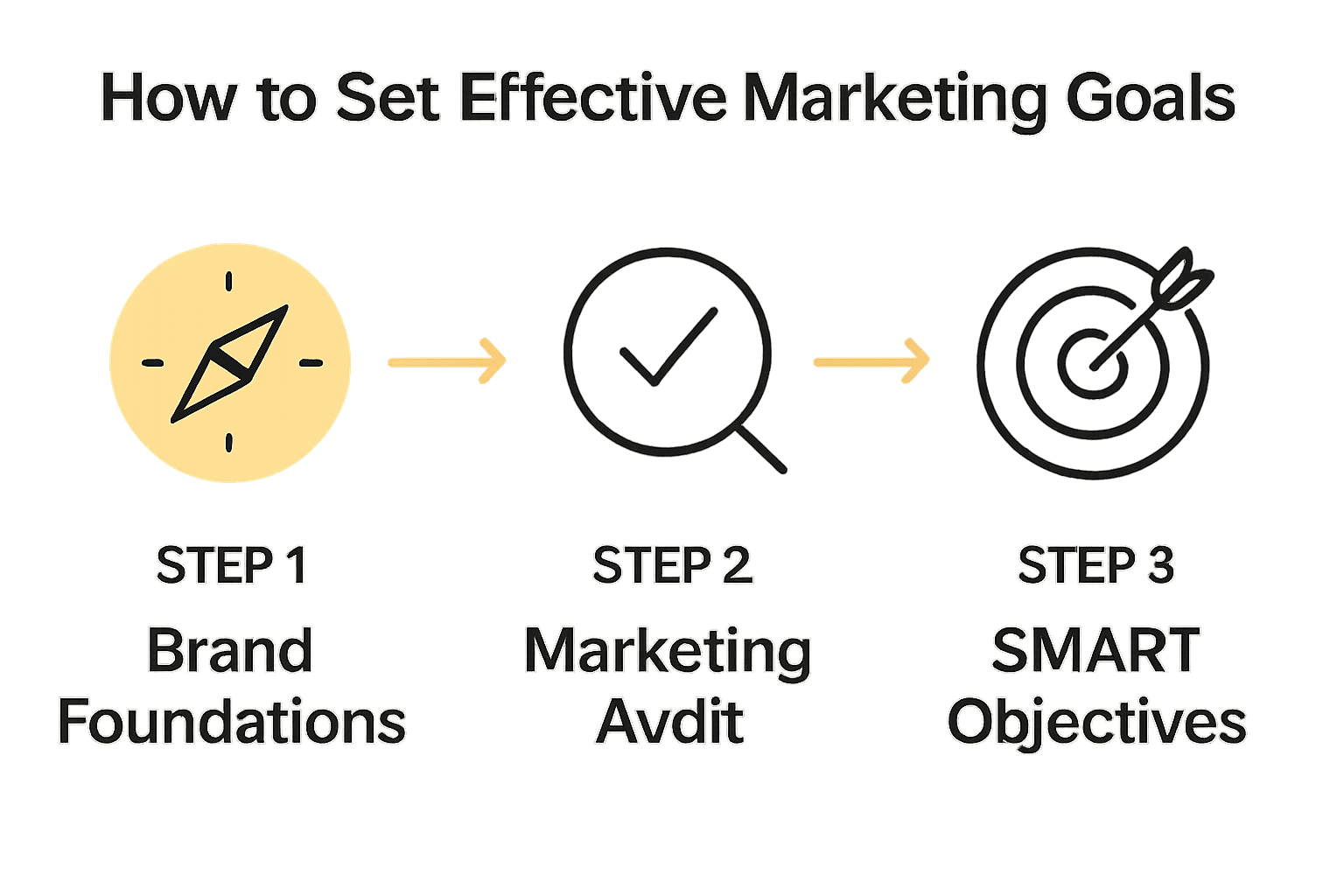7 Types of Brand Positioning Every Entrepreneur Should Know

Learn how to set marketing goals that align with your brand and business objectives. Step-by-step guide for entrepreneurs and teams to achieve measurable growth.

Most businesses waste time and money on marketing that misses the mark. Without a clear vision, even the best tactics fizzle out and results remain scattered. In fact, brands with strong foundations experience up to 23 percent more consistent growth compared to those lacking clarity. Getting your strategy right starts with understanding exactly where you are, what you want, and who you serve. This guide breaks down the proven steps to build a focused, high-impact marketing plan from day one.
This step is about creating a crystal clear roadmap that transforms your business from scattered efforts into a purposeful, aligned machine. Your brand foundations are the essential scaffolding that will support every marketing decision and growth strategy moving forward.
Starting with your business vision means understanding not just what you do, but why you do it. Ask yourself foundational questions: What problem are you solving? Who are you solving it for? What unique perspective or approach do you bring? These questions help you move beyond surface level tactics and create a meaningful connection with your audience. When your vision is sharp and well defined, your marketing becomes less about selling and more about communicating genuine value.
Your vision needs practical translation into actionable brand elements. This means defining your core values, identifying your brand archetype, and developing messaging that resonates with your ideal clients. Understanding brand clarity becomes critical here creating a north star that guides everything from your visual identity to your communication strategy. Think of this as creating an internal compass that keeps all your marketing efforts pointed in the same meaningful direction.
Pro tip: Dont try to appeal to everyone. The most powerful brands are those brave enough to be specific about who they serve and what they stand for. A focused vision attracts the right clients and repels the wrong ones and thats exactly what you want.
In this crucial step, youll systematically evaluate your existing marketing activities to uncover hidden opportunities and potential weaknesses. Think of this audit as a diagnostic tool that helps you understand where your marketing is working and where it needs serious improvement.
Start by gathering all your current marketing materials and tracking data. This means collecting everything from social media posts and email campaigns to website analytics and client interaction records. How to create a marketing plan becomes essential here youre essentially mapping out your current marketing landscape to see what strategies are delivering results and which ones are falling flat. Look for key performance indicators like engagement rates, conversion percentages, client acquisition costs, and return on investment for each marketing channel.
As you analyze your marketing efforts, pay special attention to gaps between your intended message and actual audience perception. Are your marketing materials consistently communicating your brand vision? Do they speak directly to your ideal client? Many businesses discover during this audit that their marketing lacks coherence or fails to truly connect with their target audience. Dont be afraid to be brutally honest with yourself identifying these gaps is the first step toward creating a more strategic and effective marketing approach.
Pro tip: Dont treat this audit as a one time event. Regular marketing assessments quarterly or biannually help you stay adaptive and responsive to changing market dynamics.
 Your marketing strategy should be a living document that evolves with your business.
Your marketing strategy should be a living document that evolves with your business.
In this step, youll transform your broad marketing vision into concrete, actionable goals that can be tracked and achieved. Think of your marketing objectives as the strategic GPS that guides every marketing effort toward meaningful business growth.
To create truly effective marketing objectives, use the SMART framework Specific, Measurable, Achievable, Relevant, and Time bound. For example, instead of a vague goal like “increase social media followers,” craft an objective that reads “Grow Instagram followers by 25% within the next quarter by creating weekly engaging video content.” How to build a marketing strategy becomes critical here your objectives should directly connect to your broader business outcomes. Focus on metrics that demonstrate real impact such as lead generation, conversion rates, customer acquisition cost, and revenue growth.
Break down your objectives into leading and lagging indicators. Leading indicators are predictive actions you can influence like content engagement or email open rates while lagging indicators reflect ultimate business results like sales revenue or customer retention. By tracking both, you create a comprehensive view of your marketing performance. This approach helps you stay nimble and adjust strategies quickly when something isnt working.

Pro tip: Dont set objectives in isolation. Involve your entire team in the goal setting process. When everyone understands and contributes to the marketing objectives, youre more likely to achieve them collectively.
In this critical step, youll transform your marketing strategy from guesswork to precision by deeply understanding your ideal clients psychology and their path to purchasing. Think of this as creating a detailed map that guides potential customers from first awareness to becoming loyal advocates.
Start by developing comprehensive buyer personas that go beyond basic demographics. How to develop a content strategy becomes crucial here you want to uncover not just who your audience is, but what motivates them, what challenges they face, and what emotional triggers influence their decision making. Map out each stage of their journey awareness, consideration, decision, and retention identifying specific touchpoints and potential barriers that might prevent them from moving forward. This means understanding their questions, fears, and desires at each stage and creating targeted content that speaks directly to those needs.
To truly align your marketing goals, you must think like your audience. Conduct qualitative research through interviews, surveys, and direct conversations. Listen to the language they use, the problems they describe, and the solutions they seek. Your marketing objectives should now be laser focused on solving real problems for your ideal clients. By aligning your goals with their genuine insights, you create marketing that feels less like selling and more like supporting.
Pro tip: Dont assume you know your audience. Continuously validate your assumptions through ongoing research and direct feedback. The most successful businesses are those that remain curious and adaptive to their customers evolving needs.
In this pivotal step, youll create a robust tracking system that transforms your marketing strategy from a guessing game into a precision instrument of business growth. Think of these metrics and checkpoints as your marketing GPS constantly guiding and recalibrating your journey toward tangible results.
Design a comprehensive dashboard that tracks both leading and lagging indicators across your marketing objectives. How to create a marketing strategy becomes instrumental here youll want to establish clear key performance indicators (KPIs) that directly connect to your business goals. This means creating metrics that are specific, measurable, and directly tied to revenue generation. Some essential metrics might include conversion rates, customer acquisition cost, lifetime customer value, engagement rates, and pipeline velocity. Set up quarterly review checkpoints where you systematically analyze these metrics, looking not just at the numbers but understanding the story behind them.
Importantly, your metrics should provide actionable insights. Dont just collect data create a process for interpreting and responding to what the numbers tell you. This means setting up trigger points that prompt specific actions. For instance, if your customer acquisition cost rises above a certain threshold, youll know its time to reassess your marketing channels. If engagement rates drop, youll have a predetermined protocol for content and messaging adjustments. This proactive approach ensures your marketing remains dynamic and responsive.
Pro tip: Build flexibility into your metrics. The most effective tracking systems allow for nuanced interpretation and quick pivots. Rigid adherence to metrics can be just as dangerous as ignoring them completely.
Struggling to turn clear marketing objectives into real business growth can be frustrating. This article highlights common challenges like undefined brand foundations, disconnected marketing efforts, and a lack of measurable progress. If you find yourself unsure how to align your vision with your audience or how to track meaningful results, you are not alone.
At Reasonate Studio, we understand these pain points deeply. Our proprietary Aligned Impact Model™ helps entrepreneurs and small businesses build marketing strategies rooted in clarity and intentional design. From defining your brand values to creating a practical roadmap with clear metrics, our approach ensures your marketing works cohesively to connect with your ideal clients and drive sustainable growth.
Feeling overwhelmed by scattered marketing efforts or unclear goals? Take control now and move past uncertainty.
Build your strategy on a solid foundation with how to build a marketing strategy insights and continuously refine your approach via how to create a marketing plan.

Discover how to stop guessing and start growing by partnering with Reasonate Studio. Visit Reasonate Studio to explore our tailored strategies and get the clarity your marketing needs today.
Start by asking what problem you’re solving and who you’re solving it for. Gather insights from your team and potential clients to define your unique perspective that guides all your marketing efforts.
SMART marketing objectives are Specific, Measurable, Achievable, Relevant, and Time-bound goals. For example, instead of saying “increase website traffic,” define a goal like “boost website visitors by 30% over the next quarter by implementing a targeted content strategy.”
Develop detailed buyer personas that capture your audience’s motivations, challenges, and decision-making triggers. Conduct surveys or interviews to gather qualitative insights, then craft marketing objectives that address these specific needs.
Focus on metrics that directly reflect your business goals, such as conversion rates, customer acquisition costs, and engagement rates. Set quarterly reviews to assess these KPIs and ensure they lead to actionable insights for your marketing strategies.
You should aim to conduct a marketing audit at least quarterly. This routine evaluation helps you identify gaps in your current strategy and allows you to adapt to changing market conditions effectively.
Design a dashboard that tracks both leading and lagging indicators, ensuring they tie back to your business goals. Establishing clear benchmarks within your metrics will allow you to take timely actions based on performance, such as making adjustments if engagement rates drop by 15%.